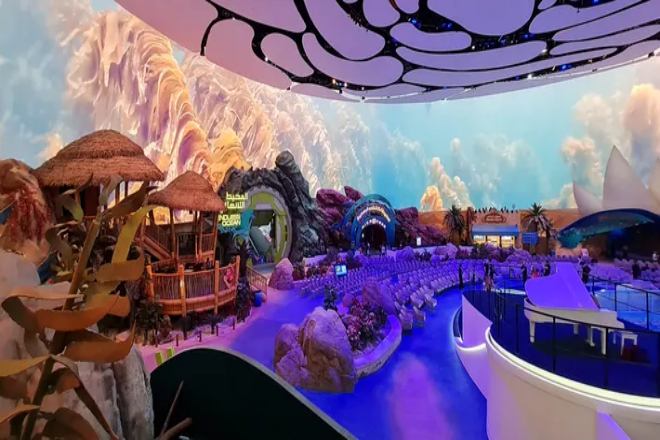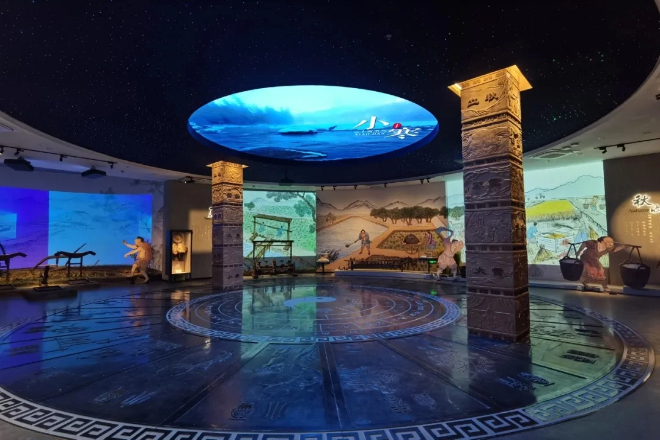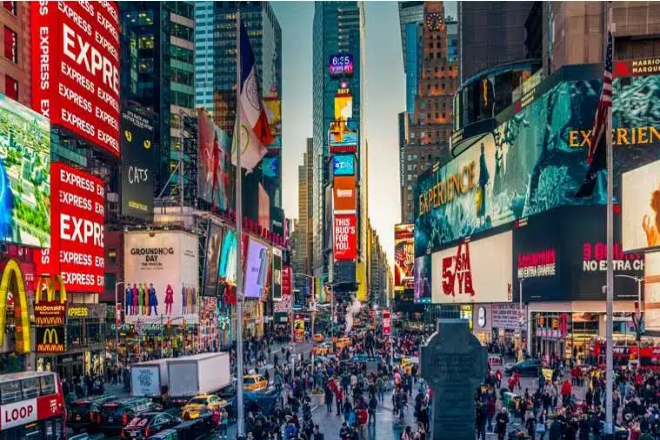Introduction
With the booming cultural tourism industry today, tourists are no longer satisfied with traditional sightseeing tours but are eager for a richer, more convenient and immersive experience.
L'émergence de Écrans d'affichage LED seems to have injected a strong vitality into the cultural tourism industry. So, how can LED display screens help the cultural tourism industry achieve a qualitative leap?
Table des matières
1. Basic functions of LED display screens in the cultural tourism industry
LED display screens can be seen everywhere in scenic spots, and they are like “information trumpets”.
For example, at the entrance of the scenic spot, the screen will scroll the introduction video of the scenic spot to tell tourists what fun and beautiful things there are here.
If there are any special activities, such as weekend concerts and folk performances on holidays, the screen will also “advertise” in advance to facilitate tourists to arrange time.
There are also large guide maps, where tourists can see where they are and how to get to the attractions they want to go, and they are no longer afraid of getting lost.
If there is bad weather or emergencies, the screen will also remind everyone to pay attention to safety in time. In short, it allows everyone to play clearly and safely in the scenic spot.
The advertising effect of LED display is quite powerful! It is like a “moving canvas”, which can show tourism products and services vividly by playing various attractive videos and pictures.
For example, if there are special souvenir shops in the scenic area, the screen can show exquisite souvenir videos so that tourists can’t help but want to buy them.
If there are hotels or homestays, they can also show comfortable accommodation environments to attract tourists to book.
Moreover, the scenic area itself can also show some good-looking promotional videos on the screen to make itself more attractive.
So that more people know that this is a place worth visiting, which will invisibly increase the popularity of the scenic area and attract more tourists.
The managers of the scenic area are also inseparable from the LED display. It is like the “big housekeeper” of the scenic area, which can help to release various notices and information.
For example, if there are new regulations, facility maintenance notices, or if there is an emergency situation that requires the evacuation of tourists, the screen can pass on the information in the first time, so that tourists can understand the situation in time.
Moreover, some smart LED screens can now be connected to the scenic area’s system to display the number of tourists and queues in real-time.
Managers can see the operation of the scenic area at a glance, which is convenient for them to adjust arrangements in time, making the management of the scenic area more efficient and orderly.
Finally, LED display screens can also provide some considerate public services.
For example, at the entrance of the scenic area or the parking lot, the screen will display traffic information to tell tourists where there are parking spaces and how to get there most conveniently.
If tourists are looking for toilets, baby rooms or rest areas in the scenic area, the screen can also provide timely guidance, allowing tourists to play more easily and comfortably in the scenic area.
Help 1: Improve the experience of tourists

1). Creating an immersive experience
LED display screens can create an immersive experience for tourists through high-definition, high-contrast images combined with audio effects.
The key to this experience is to present delicate and natural images through technologies such as ultra-large screens, high-definition résolutions et haut taux de rafraîchissement, allowing tourists to feel an immersive visual shock.
At the same time, through the cooperation of audio effects, the atmosphere is further enhanced, making tourists feel as if they are in a brand new world.
The application of LED screens is particularly prominent in theme parks, musées and historical sites.
For example, the “Star Wars: Galaxy’s Edge” theme area of Disneyland in the United States creates an immersive experience as if you are in the “Star Wars” movie through huge LED screens and surround sound effects.
Visitors can see realistic starships, alien creatures, and virtual battle scenes here, and this immersive feeling greatly enhances their experience.
In some historical sites in Europe, such as the Colosseum in Rome, LED screens are also used to display scenes of historical reproduction.
Through high-definition dynamic images and background music, visitors seem to travel back to the ancient Roman period and witness the battles of gladiators and the glory of ancient Rome.
2). Expérience interactive améliorée
LED screens can not only provide an immersive visual experience but also support a variety of interactive functions, such as touch screens, gesture recognition, somatosensory interaction, etc.
These functions greatly stimulate the sense of participation of visitors, allowing them to change from passive viewing to active participation, thereby extending their stay in scenic spots or exhibitions.
In some science and technology museums in Europe, such as the Berlin Museum of Technology in Germany, LED displays combine touch screens and gesture recognition technology, allowing visitors to explore exhibit information through simple gestures.
For example, visitors can zoom in or out of the exhibit’s 3D model and view detailed information through gestures. This interactive experience greatly enhances the visitor’s sense of participation.
In temporary exhibitions at the Louvre in France, LED displays are used to display interactive artworks.
Visitors can interact with artwork by touching the screen, such as changing the colour of the picture, adjusting the layout of the work, etc.
This interactivity not only makes visitors feel fresh and interesting but also prolongs their stay in the exhibition.
Through high-definition, high-contrast images and interactive functions, LED displays provide visitors with an immersive and interactive experience, greatly improving visitors’ satisfaction and sense of participation.
The application of this technology not only enriches the content of the cultural and tourism industry, but also brings a new way of experience to tourists.
Help 2: Assisting the digital transformation of the cultural and tourism industry
1). Smart guide and navigation
The LED display is like a “smart tour guide” in the scenic area. When combined with various high-tech systems, it can guide and explain to tourists and plan routes.
Imagine that you walk into a huge scenic spot without a map in your hand, and you don’t have to worry about getting lost.
Look at the LED screen; it can tell you where you are now, how to get to the nearest attractions and recommend routes based on your preferences, such as whether you like natural scenery or historical culture.
If you go to a place like Yellowstone National Park in the United States, the LED screen can also be linked with your mobile phone’s GPS to update the location in real-time, allowing you to easily visit the entire scenic spot.
When traveling in some big cities, such as Paris, there will also be LED screens by the river or near scenic spots.
These screens can not only tell you what attractions are here, but also tell you what delicious and fun things are nearby, and even explain to you in different languages, which is very convenient!
2). Data analysis and precision marketing
There is actually a “data brain” hidden behind the LED display.
It can quietly record how long tourists stay in front of the screen, what content they click on, and what they are most interested in. Scenic spots and businesses can push things that tourists may like based on these data.
For example, in Disneyland France, if you always stay in front of the advertisement of a certain amusement project for a long time, the LED screen will push you more discount information or surrounding activities about this project.
In this way, tourists can see the content they are really interested in, and businesses can promote more accurately, and everyone can benefit.
In some urban tourist centres, LED screens can also recommend attractions and activities suitable for tourists based on their previous behaviour.
For example, if you always stop in front of the introduction of the history museum before, the screen will recommend more similar attractions and will also tell you what special shops are nearby and what fun souvenirs you can buy.
In this way, tourists can not only have fun but also find what they like, and the consumption experience will naturally improve.
Through these functions, LED display screens not only make it easier for tourists to play in scenic spots but also help scenic spots and businesses better understand tourists’ needs and provide more considerate services.
Help 3: Improve the operational efficiency of the cultural and tourism industry

1). Information management and real-time update
Imagine that you work in a scenic spot. In the past, updating the scenic spot information required manual poster replacement and posting of notices, which was not only time-consuming and labor-intensive, but also prone to errors.
Now with LED display screens, all these troubles are gone! The LED display is like a “smart housekeeper”.
Through the background system, the staff can update the content on the screen anytime and anywhere, whether it is a scenic spot map, activity information, or weather forecast, it can be done instantly.
For example, if there is a sudden weather change and the scenic spot needs to temporarily close a certain scenic spot, the staff only needs to operate in the background, and the latest notification will be displayed on the LED screen immediately.
Tell tourists, “The road ahead is closed, please detour” or “The scenic spot is temporarily closed, please understand.”
This rapid response capability can not only reduce the inconvenience of tourists but also make the management of the scenic spot more efficient and flexible.
In large scenic spots or urban tourism, this advantage is more obvious. For example, in Times Square, huge LED advertising screens display information on various activities and emergency notices every day.
Once there is an emergency, such as traffic control or concert cancellation, the screen content can be quickly updated to let tourists know the situation the first time and avoid confusion.
2). Cost-benefit analysis
Let’s talk about the cost. In the past, scenic spots used traditional display methods, such as paper posters and banners, which not only wasted paper but also easily faded and damaged.
Moreover, every time the content is updated, it has to be reprinted and posted, which is time-consuming and expensive.
The LED display is different. It is like a “money-saving expert”. Although the initial investment may be a bit high, it is definitely cost-effective in the long run.
First of all, the service life of LED display is very long, generally it can be used for several years, and daily maintenance is particularly simple.
As long as you check the line regularly and clean the dust, there is basically no big problem.
Secondly, LED display is particularly energy-saving. It can automatically adjust the luminosité according to the ambient light.
Unlike traditional light boxes, it runs at full power regardless of day or night, and consumes amazing power.
For example, a medium-sized scenic spot may spend tens of thousands of yuan on traditional promotional materials every year, and it has to arrange for special personnel to be responsible for replacement and maintenance.
After switching to LED display, although the initial equipment investment may be hundreds of thousands, the annual maintenance cost and power consumption may be less than half of the traditional method.
Moreover, LED displays can detect faults in time through a remote monitoring function, reducing maintenance time and cost.
In general, LED displays can not only make the information management of scenic spots more efficient but also save a lot of money on energy saving and maintenance.
This kind of “killing two birds with one stone” good thing is definitely a “secret weapon” for the cultural and tourism industry to improve operational efficiency.
Help 4: Improve the cultural communication ability of the cultural tourism industry
1). Cultural display and inheritance
The LED display is like a “super story machine”. Through high-definition images and dynamic displays, it can tell local culture and historical stories vividly.
Imagine that the cold cultural relics in the museum before can now be turned into animations, videos, and even interact with the audience through LED screens.
For example, in some historical museums, visitors can see the 3D models of cultural relics by touching the screen and can also hear the stories behind the cultural relics.
This vivid display method makes culture no longer high above but within reach.
In cultural museums and historical districts, the application of LED displays is particularly interesting.
For example, in the Daming Palace Memorial Hall in Xi’an, the screen shows the historical changes of the Daming Palace through animation, making tourists seem to travel back to the Tang Dynasty.
In some ancient towns, LED displays can display local folk culture, such as traditional skills such as paper cutting and embroidery.
Visitors can not only watch but also try to do it themselves through interactive screens. This experience is particularly strong.
2). Cross-cultural communication and promotion
In international tourism, LED display screens are like a “cultural translator” to help spread local culture.
Now many museums and scenic spots have set up multilingual LED screens, so no matter which country you are from, you can easily understand the exhibition content.
For example, in the Canadian Science and Technology Museum, the screen displays Canada’s scientific and technological achievements and historical culture in multiple languages, allowing foreign tourists to easily “understand” Canada.
In some international cultural exchange activities, LED display screens are even more impressive.
For example, in activities that showcase Chinese traditional culture, foreign tourists can also feel the charm of Chinese culture through the dynamic display and multilingual interpretation of LED screens.
This way of display not only allows culture to “go out” but also attracts more foreign tourists to experience it, driving the sales of cultural and creative products and allowing more people to understand China’s traditional culture.
Help 5: Drive the development of a local tourism-related economy

LED display screens can not only bring a better experience to tourists but also quietly drive the local tourism economy.
Simply put, it is like a “super salesman”, showing all the fun, delicious and easy-to-buy local things, allowing tourists to “buy, buy and buy” willingly, and at the same time driving various related industries around to make money together.
1). Attract tourists and increase income
The LED display is like a “living advertisement”, showing the local beautiful scenery, fun places and special activities clearly. When tourists see these attractive pictures, they will naturally want to see them more.
For example, by putting a large screen at the entrance of the scenic spot to show the preferential activities of surrounding hotels or the food of special restaurants, tourists will be more willing to stay and eat, so tourism income will naturally increase.
2). Make the tourism industry chain “live”
Tourism is actually a “big family”, and scenic spots, hôtels, restaurants, and transportation are indispensable. The LED display is like the “liaison” of this big family, connecting everyone.
For example, scenic spots can promote the discounts of surrounding hotels on the screen, and hotels can also promote the activities of scenic spots.
Everyone works together, tourists have fun, and merchants can also make money by killing two birds with one stone.
3). Enhance the brand and attract investment
If a place’s tourism brand is well done, it is like a “golden signboard” that can attract more tourists and investors. LED display screens make this place more attractive by showing the local culture and beautiful scenery.
When investors see the potential here, they will be willing to invest in building new hotels and developing new projects, so that the tourism economy can grow bigger and bigger.
4). Drive the sales of cultural and creative products
Cultural and creative products are very popular now, and LED display screens can show their talents.
It can show local culture and cultural and creative products through animations and videos, making tourists feel fresh and interesting.
For example, in museums, the screen displays the design inspiration of cultural and creative products. Tourists are interested in it and are willing to buy it home, which not only increases income but also spreads culture.
7. Conclusion
Through the above introduction to the various applications and advantages of LED display screens in the cultural and tourism industry, we can clearly see that they have become a powerful booster for the development of the industry.
From improving the experience of tourists to promoting the digital transformation of the industry, from optimizing operational efficiency to promoting cultural communication, LED display screens have shown great potential and value.
Enfin, si vous souhaitez en savoir plus sur les écrans d'affichage LED, veuillez nous contacter.
